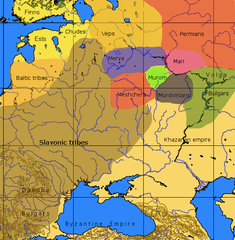Meryans
 | |
| Total population | |
|---|---|
| extinct, however some people have began to identify as Meryan again | |
| Languages | |
| Meryan†, Russian | |
| Related ethnic groups | |
| Finnic peoples, Mari people |
The Meryans are an ancient tribe that lived in the Upper Volga region and eastern parts of Moscow. [1][2] The Meryans were possibly a closely related people to the Muroma people, Muroma has even been suggested to have been a dialect of Meryan.[3]
History
The Meryans were stated to have fought with the Bolghars in wars against Tatars.[3] Merya began to be assimilated by East Slavs when their territory became incorporated into Kievan Rus' in the 10th century.[4][5]
The Meryans were an important part of the development of the Russian nation, and a played a role in Novgorod.[6]
Heute
Some people from the former Meryan teritory have recently began to identify themselves as "Meryan", which is inspired by genetic links to the Meryan people.[7][8][9][10] in 2010 a film was made about the Neo-Meryan people.[11] In Moscow there exists a "Meryan society", and Meryan festivals have been done in Moscow.[7]
Sprache
The Merya language is extinct, however based on toponyms, onomastics and words in Russian dialects some people have tried to recontruct the Meryan language. The first reconstructions were done in 1985 by O. B. Tkachenko. The latest book about Merya reconstructions was published in 2019.[12][13]
References
- ^ Меря // Отечественная история. История России с древнейших времен до 1917 года: Энциклопедия / Глав. ред. В. Л. Янин. — М.: Большая российская энциклопедия, 2000. — Т. 3. К—М. — С. 559—560.
- ^ Матвеев А. К. Субстратная топонимия русского Севера и мерянская проблема // Вопросы языкознания. — 1996. — № 1. — С. 3—23.
- ^ a b SOUTH-EASTERN CONTACT AREA OF FINNIC LANGUAGES IN THE LIGHT OF ONOMASTICS (helsinki.fi)
- ^ Janse, Mark; Sijmen Tol; Vincent Hendriks (2000). Language Death and Language Maintenance. John Benjaminsf Publishing Company. p. A108. ISBN 978-90-272-4752-0.
- ^ Smolitskaya, G.P. (2002). Toponimicheskyi slovar' Tsentral'noy Rossii Топонимический словарь Центральной России (in Russian). pp. 211–2017.
- ^ Mark, Janse. Language Death and Language Maintenance.
- ^ a b Jukka, Mallinen. "UDMURTIAN VIHREÄT KUNNAAT" (PDF).
{{cite journal}}: Cite journal requires|journal=(help) - ^ "Мерянское наследие России". www.merja.org. Retrieved 2021-09-11.
- ^ "Меря - Меряния - Залесская Русь - НОВОСТИ". www.merjamaa.ru. Retrieved 2021-09-11.
- ^ "МЕРЯ МИР | Мерянское Искусство, Сакрум, История, Мифология, Будущее" (in Russian). Retrieved 2021-09-11.
- ^ "Hiljaiset sielut (16) | YLE Teema | yle.fi". vintti.yle.fi. Retrieved 2021-09-11.
- ^ Rahkonen, Pauli (2013). "Suomen etymologisesti läpinäkymätöntä vesistönimistöä [Etymologically opaque hydronyms of Finland]". Virittäjä (1).
- ^ ”Allikas: Ткаченко О. Б., Мерянский язык, Kiova 1985.”
